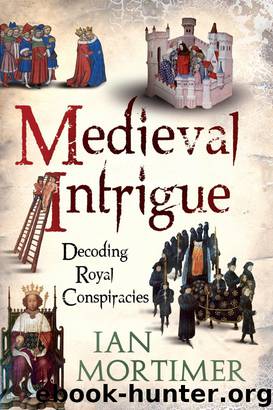Medieval Intrigue: Decoding Royal Conspiracies by Ian Mortimer

Author:Ian Mortimer [Mortimer, Ian]
Language: eng
Format: epub
Tags: History, Medieval, England/Great Britain, Nonfiction, Royalty
ISBN: 9781847065896
Publisher: A&C Black
Published: 2010-06-14T16:00:00+00:00
6. EDWARD III, HIS FATHER AND THE FIESCHI
What did happen to Edward II? The inevitability of that question in the wake of the preceding pages is not matched by an equally inevitable answer. The principal source for Edward II’s life after 1330 – the Fieschi Letter – has been dismissed as a fraudulent document by scholars in the past, and it is right to approach it with caution. Just because Edward II did not die in 1327 does not mean that any documents claiming to account for his later life should automatically be trusted. We could draw up a hypothesis that it was created by a blackmailer who knew about Edward II’s survival – a disaffected adherent of the earl of Kent, for example. So, while ignoring it would obviously be counterproductive – and no wiser than ignoring any other piece of contemporary evidence – it seems sensible to start by setting it aside and considering what we know of Edward II’s possible survival from other sources.
Three lines of enquiry present themselves at the outset, namely (1) Edward III’s attempts to resolve the problem of his father’s survival; (2) matters connected with Edward II’s supposed death that were still pending after 1330; and (3) the one official piece of direct evidence that referred to Edward II as alive after 1330 – at least in the minds of the English royal household. It goes without saying that, even collectively, these do not amount to very much. However, it equally goes without saying that this is not surprising, given Edward III’s evident determination to allow no public discussion of his father’s possible survival and his systematic destruction of certain records that would have proved useful to historians in researching his secret activities after 1330. For a start, he personally burnt the chamber accounts for the whole period of Thomas Hatfield’s responsibility on 4 December 1344, so none survive between John Flete’s account of 1333–34 and that date. 1 In addition, a royal clerk attempted to eradicate the official record of the reference to a meeting of Edward III and the woman who embalmed the body supposed to be that of his father. 2 The destruction of all the Parliament Rolls between September 1327 and March 1330 – the entire period of the dominance of Mortimer and Isabella – is probably no coincidence. 3 We can say the same regarding the lack of an official copy of the Fieschi Letter. Edward destroyed any records that might cast doubt upon his regnal legitimacy.
Edward III’s quest for information relating to the events of 1327–30 would have involved men whom he knew and trusted, like Archbishop Melton and Lord Berkeley. However, such conversations have left nothing in terms of evidence. Thus we need to turn to the king’s several attempts to track down William de Kingsclere, Thomas Gurney and Sir John Maltravers. De Kingsclere was arrested in Rochester in 1332; his fate is unknown. Gurney was arrested, escaped, was recaptured, fell sick, and then was nursed
Download
This site does not store any files on its server. We only index and link to content provided by other sites. Please contact the content providers to delete copyright contents if any and email us, we'll remove relevant links or contents immediately.
| Africa | Americas |
| Arctic & Antarctica | Asia |
| Australia & Oceania | Europe |
| Middle East | Russia |
| United States | World |
| Ancient Civilizations | Military |
| Historical Study & Educational Resources |
Elizabeth by Philippa Jones(1862)
Mary Boleyn by Alison Weir(1465)
Traitors of the Tower by Alison Weir(1359)
A Journal of the Plague Year (Oxford World's Classics) by Daniel Defoe(1228)
Eleanor of Aquitaine by Marion Meade(1084)
Moon Tiger by Penelope Lively(1070)
A Short History of England by Simon Jenkins(1066)
The Real Middle Earth by Brian Bates(1049)
Life of Pi by Yann Martel(1031)
London Under by Peter Ackroyd(1017)
Notes From a Small Island by Bill Bryson(1010)
Queen Isabella by Alison Weir(1005)
American Idol by Richard Rushfield(924)
Her Majesty's Spymaster by Stephen Budiansky(909)
Tudors Versus Stewarts by Linda Porter(905)
Albion by Peter Ackroyd(838)
Cromwell, Our Chief Of Men by Fraser Antonia(814)
The Creation of Anne Boleyn by Susan Bordo(813)
Children Of England: The Heirs of King Henry VIII 1547-1558 by Weir Alison(812)
